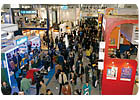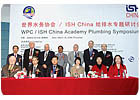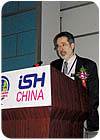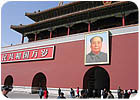
ISH China 2006 drew more than 15,000 visitors, the largest attendance ever.
When it comes to plumbing and heating, China has big problems. A quickening pace of urbanization has left China with 661 cities that are home to about 42% of its 1.3 billion people. Yet, much of China's vast land mass is arid. Its per capita water resources are equal to only about a quarter of the world average. Nearly two-thirds of China's cities do not have sufficient water supply, and one in every six cities suffers from severe water shortage. This is exacerbated by widespread pollution of both surface and underground water supplies. It's estimated that around 90% of China's river sections are heavily polluted. (All data cited here comes from Xinhua, the Chinese government's official news agency.)
The nation's heating infrastructure is little better. By 2002, only 40% of China's total housing had heating, with electric seeming the most common mode. Hydronic heating has started to make significant inroads into the market, and was prominent among the displays at ISH China 2006, held in Beijing March 14-17.
The sixth version of ISH China featured 293 exhibitors from 19 countries and regions, and 15,307 visitors streaming in from 45 countries. Among them were American companies A.O. Smith, Honeywell, Rheem, SPX and Weil-McLain, along with standard and code agencies NSF and IAPMO. Canada's tekmar also was present.
“We've been at ISH China since 2000, but it was only in 2004 that we started to sell our boilers in this market through local representatives,” said Paolo Azzali, export manager for Immergas of Italy. “Since that time, we have sold over 30,000 boilers in Beijing alone. The market is clearly ready for us. Condensing boilers are relatively new here and demand is growing year by year. ISH China has unquestionably helped us increase our presence and develop our brand in China.”
There was much talk at the fair about the Chinese Renewable Energy Law that became effective in January 2006, and how that would affect suppliers in the heating and air conditioning industry.
“The five-year plan of the Chinese government that was presented recently places emphasis on the improvement of energy efficiency. This highly ambitious program for energy savings opens up numerous sales opportunities, especially for German producers,” said Dr. Uwe Schwarting, managing director of Deutscher Großhandelsverband Haustechnik e.V. (The German association of wholesalers for sanitary and heating equipment). “The Chinese market offers interesting sales opportunities in the field of solar energy, energy saving and efficient cooling and air conditioning equipment. A trade fair like this is the best opportunity to inform potentially interested parties.”
“Both the quality and the quantity of visitors at ISH China has dramatically increased and improved,” said Volker Both, general manager, marketing and sales-China for Vaillant, a German manufacturer of condensing boilers utilizing renewable energy. “We received a great response to our energy-efficient products, which we are showing for the first time.”
China's energetic business environment crackled throughout the four-day event, which featured three technical symposia. Held on March 14 was a presentation by the Danish Board of District Heating detailing energy saving solutions by Danish companies participating in that technology. The next day featured a Sino European Congress on modern energy saving equipment for heating and air conditioning of buildings, with technical presentations by some of Europe's leading boiler and controls companies.

Participants and organizers of the World Plumbing Council symposium.
WPC Symposium
March 16 was occupied by The WPC / ISH China Academy Plumbing Symposium - the first event jointly organized by the World Plumbing Council and Messe Frankfurt in China, and sponsored by IAPMO. The event was divided into three sessions concerned with:- Drainage design & public health.
- Water conservation & environmental protection.
- Global training in the water industry.
The drainage design program included a presentation by Professor Daniel Chan Wai-tin of the Hong Kong Polytechnic University explaining how vertical stack design was believed to be one of the routes for the SARS virus transmission in a Hong Kong high-rise building, and how to solve the problem.
Also, Zhang Tong of the Beijing Special Engineering Design Institute presented an overview of China's poor level of water resource management, which he blamed largely on government control. “There is no severe punishment for the users that heavily waste the water resources, which show no efficiency principles … and reduce the enthusiasm for the people to protect the water resources,” said Tong (translation provided).

Dr. Jose Hueb of the World Health Organization.
Highlighting the water conservation segment was a review of Hong Kong's program of using salt water to flush toilets by Dr. Lam Lap Kay of the city's Water Supplies Department. The program originated in 1958, and as of 2004, converted salt water (via an electro-chlorination process) provided about 80% of Hong Kong's flushing needs.
Also, German engineer Christian Wilhelm detailed his work under commission from the Chinese government to utilize rainwater, recycling and other water management techniques for the 2008 Olympic Park and other big projects.
In another presentation, India's John Joseph, principal consultant and managing director of M/s John Mechanical Technologies, one of the leading electrical-mechanical engineering consulting firms in India, drew the audience's attention to the fact that while 70% of the earth's surface is covered by water, only 3% is available for human consumption. Most of that, he added, is in inaccessible polar regions.
The global training session was led by John Smartt, head of plumbing and refrigeration in the School of Construction, Dublin Institute of Technology, who detailed his travels of the UA training systems under a trainer/lecturer scholarship program initiated by the international plumbers union.
Robert Burgon, a WPC board member who represents Scotland and Northern Ireland plumbing-heating trade organizations, warned of the danger of “fast track training solutions,” which have become common in the United Kingdom, owing to the shortage of skilled plumbers.
WHO lends its stature
Another mark of distinction for ISH China was the presence of a representative of The World Health Organization (WHO) in Geneva, Switzerland. Dr. José Hueb from the Water, Sanitation and Health Office attended the event and helped unveil a new manual on “Health Aspects of Plumbing,” in collaboration with the WPC. It is an updated version of a publication formerly called “Guidelines on Health Aspects of Plumbing,” originally produced by the World Health Organization in 1982, and revised in 1998 in cooperation with the WPC, with the IAPMO Group acting as project coordinator. “Health Aspects of Plumbing” contains guidelines that can be used by developing nations as they try to establish criteria for the installation and maintenance of plumbing systems. The resulting regulations, if implemented properly, ensure safe drinking water as well as the proper removal of sewage, thus providing sanitary conditions.“The proportion of people around the world having access to plumbing systems is extremely small,” said Dr. Hueb. “Only 50% have access through piped systems within the household itself, and 30% have flushing toilets discharging to public sewers. The prospects of growth are huge, and it is crucial that the millions of future plumbing systems be designed, constructed and maintained properly so that health concerns are taken into account.”

Random Notes From ISH China
- There is little systematic training taking place in China to produce skilled plumbing-heating professionals. Henry Hung, a prominent mechanical contractor from Hong Kong and WPC board member, told me that the government is not involved in any type of apprenticeship efforts, and that while a number of trade associations have tried to pick up the slack, none has done so in any noteworthy way. Hung added that the main reason our hotel had signs warning against drinking from the tap was not because of problems with Beijing's water supply, but lack of confidence in the plumbing installers.
- NSF has expanded its global certification services to the People's Republic of China via establishment of NSF Shanghai Co. Ltd., a joint venture between NSF International and Shanghai Audit Center of Quality System.
- Someone told me Kohler is now the largest plumbing manufacturer in China, with six factories, 400 outlets and seven flagship stores throughout the country. One of those showrooms was located about a half-mile from the exposition site. On the first day of my visit, China Daily, an English language newspaper, had a big feature article about Kohler's targeting of the luxury market in China.
- Lots of radiation was on display at ISH China, although much of it was electric. Electricity has been very cheap throughout the country. Wall-hung boilers seemed the order of the day, owing to limited living space.
- As in ISH Frankfurt, the Big Three European boiler makers - Vaillant, Viessmann and Buderus - contended for attention with giant banners outside the exhibition hall. They also occupied adjacent space in the heating area of the exposition, albeit with displays a tiny fraction of the size they occupy in Frankfurt.
- Beijing's streets are anarchy come alive with cars, buses, pedestrians and bicyclists all striving to occupy the same space at the same time. Lane markers and traffic lights are purely advisory. China's motorists must have the world's best visual acuity what with cars routinely coming literally within inches from collisions at all times. A cab I was riding in came thisclose to hitting a cop car he swerved in front of. The cops didn't blink an eye. I never saw an accident, but they must happen quite a bit. In fact, I think it would be a win-win for both societies if the United States could find a way to export about 90% of its personal injury attorneys to China. Think of what it would do to help rectify the massive trade imbalance.
